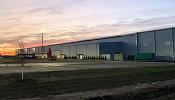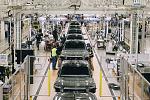Contributing Writer
- FMA
- The Fabricator
- FABTECH
- Canadian Metalworking
Categories
- Additive Manufacturing
- Aluminum Welding
- Arc Welding
- Assembly and Joining
- Automation and Robotics
- Bending and Forming
- Consumables
- Cutting and Weld Prep
- Electric Vehicles
- En Español
- Finishing
- Hydroforming
- Laser Cutting
- Laser Welding
- Machining
- Manufacturing Software
- Materials Handling
- Metals/Materials
- Oxyfuel Cutting
- Plasma Cutting
- Power Tools
- Punching and Other Holemaking
- Roll Forming
- Safety
- Sawing
- Shearing
- Shop Management
- Testing and Measuring
- Tube and Pipe Fabrication
- Tube and Pipe Production
- Waterjet Cutting
Industry Directory
Webcasts
Podcasts
FAB 40
Advertise
Subscribe
Account Login
Search
New vehicle mileage standards released; Tesla raises concerns about steel tariffs
The increases don’t seem huge for metal stampers, but some in the industry remain skeptical that they can be achieved easily
- By Stephen Barlas
- May 9, 2022

Corporate average fuel efficiency standards are being increased, starting with the 2024 model year. paksongpob kasempisaisin/iStock/Getty Images Plus
The federal rule establishing new car mileage standards published in the Federal Register probably means that metal forming companies in automobile supply chains won’t be forced too far outside their current technology comfort zones.
The National Highway Traffic Safety Administration (NHTSA) published its corporate average fuel efficiency (CAFE) standards for model years 2024-2026 in May. The standards increase by 8% for each of the three years over those from the previous administration. That won’t be too much of a stretch for many metal stamping companies because they won’t have to tinker too much with their steel and aluminum inputs.
Thomas McCarthy, senior vice president, head of technical safety and regulatory compliance, Stellantis, which is a combination of Fiat Chrysler Automobiles and the French PSA Group, said some newer technologies such as efficient AC compressor clutches and brushless blower motors will have to be used more extensively than currently.
But the Alliance for Automotive Innovation (AAI) counters those who argue integration of off-the-shelf technologies and components won’t be a problem.
“This view ignores that technologies can’t simply be ‘bolted on’ to existing engines,” an AAI statement said. “Instead, they must be carefully integrated into existing designs, requiring engineering resources, and, in many cases, new engine designs. A new engine design can cost as much as $1 billion.”
The NHTSA standards for 2024-2026 are supposed to align with the Environmental Protection Agency's (EPA) greenhouse gas emission standards for autos for 2023-2026. The EPA standards translate to a 10% CAFE improvement in model year 2023 followed by 5% increases per year through model year 2026. That equates to a 7-g/mile tougher mark when comparing the NHTSA standards to the EPA standards in model years 2025 and 2026. That could be a problem.
NHTSA states in the proposal that the discrepancies in what the two agencies’ standards require become smaller each year, until alignment is achieved. In a statement, the Motor & Equipment Manufacturers Association (MEMA) said it’s not as confident: “However, due to the limitations in flexibilities in NHTSA’s program, full alignment is still elusive.”
Tesla Enters the Tariff Exclusion Fight
Big-name political heavyweights are getting involved for the first time in an effort to convince the U.S. Department of Commerce’s Bureau of Industry and Security (BIS) to make it easier to get exclusions from the Section 232 tariffs on imported steel and aluminum. (This calls for a 25% tariff on imported steel and a 10% tariff on imported aluminum.) Tesla, absent from the steel tariff debate in recent months, although vocal in opposition to China tariffs early in the debate, is weighing in now. The company is concerned about snags in its domestic supply chain which reaches 40 states in the U.S.
Miriam Eqab, Tesla’s associate general counsel for trade, said while the company wants a healthy domestic steel manufacturing industry, the electric vehicle manufacturer is having problems getting the steel it needs from U.S. suppliers and is having its exclusion requests thwarted.
“While Tesla has been granted several exclusions, the company has had other submissions for exclusions denied due to the submission of questionable, unsupported objections by domestic producers,” she wrote. “BIS’ apparent reliance and/or deference to these objections has made the exclusion process inequitable and foreclosed justified tariff relief based on real unavailability of domestic supply.”
In a separate statement, Tri Star Metals said its expansion plans have in some cases been hindered by denied exclusion requests. Tri Star, a distributor of stainless-steel bar, rod, and wire, and a provider of semifinished products to more than 3,000 customers in the U.S., said, “The lack of formality and uncertain nature of the Section 232 exclusion process has made long-term planning and strategic investment difficult, inhibiting our ability to grow Tri Star’s operations.”
But steel manufacturers and the steelworkers countered that importers are abusing the exclusion process. Roy Houseman, legislative director for the United Steelworkers, argued: “We are concerned, however, that the gains that have been made in rebuilding the domestic steel industry could be put at risk if the strength of the 232 tariffs is further eroded through increased country exemptions and product exclusions that are not justified.”
subscribe now

The Fabricator is North America's leading magazine for the metal forming and fabricating industry. The magazine delivers the news, technical articles, and case histories that enable fabricators to do their jobs more efficiently. The Fabricator has served the industry since 1970.
start your free subscriptionAbout the Author

Stephen Barlas
- Stay connected from anywhere

Easily access valuable industry resources now with full access to the digital edition of The Fabricator.

Easily access valuable industry resources now with full access to the digital edition of The Welder.

Easily access valuable industry resources now with full access to the digital edition of The Tube and Pipe Journal.
- Podcasting
- Podcast:
- The Fabricator Podcast
- Published:
- 05/07/2024
- Running Time:
- 67:38
Patrick Brunken, VP of Addison Machine Engineering, joins The Fabricator Podcast to talk about the tube and pipe...
- Trending Articles
White House considers China tariff increases on materials

A deep dive into a bleeding-edge automation strategy in metal fabrication

A visit to Automate 2024 reveals the future might be now

Majestic Steel Arkansas fully operational

Rivian to expand Illinois facility to manufacture midsized SUV

- Industry Events
Laser Welding Certificate Course
- May 7 - August 6, 2024
- Farmington Hills, IL
World-Class Roll Forming Workshop
- June 5 - 6, 2024
- Louisville, KY
Advanced Laser Application Workshop
- June 25 - 27, 2024
- Novi, MI
Precision Press Brake Certificate Course
- July 31 - August 1, 2024
- Elgin,


























